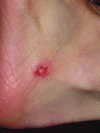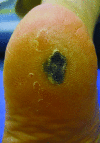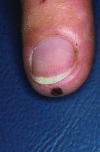Sports Dermatology: Part 1 of 2 Traumatic or Mechanical Injuries, Inflammatory Conditions, and Exacerbations of Pre-existing Conditions
- PMID: 26060516
- PMCID: PMC4456799
Sports Dermatology: Part 1 of 2 Traumatic or Mechanical Injuries, Inflammatory Conditions, and Exacerbations of Pre-existing Conditions
Abstract
Competitive athletes endure extreme bodily stress when participating in sports-related activities. An athlete's skin is particularly susceptible to a wide array of repetitive physical and environmental stressors that challenge the skin's protective function. Many unique dermatoses are well-known to the serious athlete due to countless hours of intense physical training, but are frequently unrecognized by many healthcare professionals. Sports dermatology is a distinctive, budding field of dermatology that focuses on dermatoses frequently encountered in athletes. Athletic skin problems are notoriously infectious in nature due to the inherent environment of close-contact physical activity. Nonetheless, other skin conditions can manifest or worsen with recurring mechanical or traumatic injury or exposure to environmental hazards. Additionally, sports-related activities may exacerbate other pre-existing dermatological conditions that may possibly be unknown to the athlete or clinician. The objective of this two-part review is to arm the astute physician with the fundamental knowledge of the range of dermatological conditions distinct to the competitive athlete. Knowledge of these cutaneous conditions in the context of specific sporting events will permit the clinician to manage these unique patients most effectively. Part one will focus on traumatic or mechanical injuries, inflammatory conditions, and exacerbations of pre-existing conditions frequently seen in athletes.
Figures










Similar articles
-
Dermatologic disorders of the athlete.Sports Med. 2002;32(5):309-21. doi: 10.2165/00007256-200232050-00003. Sports Med. 2002. PMID: 11929358 Review.
-
Skin manifestations of athletes competing in the summer olympics: what a sports medicine physician should know.Sports Med. 2012 May 1;42(5):399-413. doi: 10.2165/11599050-000000000-00000. Sports Med. 2012. PMID: 22512412 Review.
-
Training room management of medical conditions: sports dermatology.Clin Sports Med. 2005 Jul;24(3):565-98, viii-ix. doi: 10.1016/j.csm.2005.03.008. Clin Sports Med. 2005. PMID: 16004920 Review.
-
Dermatologic aspects of sports medicine.J Am Acad Dermatol. 1980 Oct;3(4):415-24. doi: 10.1016/s0190-9622(80)80337-9. J Am Acad Dermatol. 1980. PMID: 7430463
-
Dermatological problems in the athlete.J Orthop Sports Phys Ther. 1996 Jun;23(6):388-402. doi: 10.2519/jospt.1996.23.6.388. J Orthop Sports Phys Ther. 1996. PMID: 8727020 Review.
Cited by
-
A novel treatment of intertrigo in athletes and overweight subjects.J Cosmet Dermatol. 2021 Apr;20 Suppl 1(Suppl 1):23-27. doi: 10.1111/jocd.14097. J Cosmet Dermatol. 2021. PMID: 33934472 Free PMC article. Clinical Trial.
-
Acral pebbles: A novel manifestation of partially treated syphilis.Indian J Sex Transm Dis AIDS. 2017 Jan-Jun;38(1):92-94. doi: 10.4103/0253-7184.203431. Indian J Sex Transm Dis AIDS. 2017. PMID: 28442813 Free PMC article.
-
Prevalence of Skin Injuries in Beach Volleyball Athletes in Greece.J Clin Med. 2024 Apr 5;13(7):2115. doi: 10.3390/jcm13072115. J Clin Med. 2024. PMID: 38610879 Free PMC article.
-
Surfing and skin: evaluating emergency dermatological injuries and conditions attributed to surfing and windsurfing between 2021 and 2023 using a public database.Arch Dermatol Res. 2024 Nov 30;317(1):60. doi: 10.1007/s00403-024-03563-3. Arch Dermatol Res. 2024. PMID: 39615001 No abstract available.
-
More Than Skin Deep: Dermatologic Conditions in Athletes.Sports Health. 2023 Jan-Feb;15(1):74-85. doi: 10.1177/19417381211065026. Epub 2022 Jan 17. Sports Health. 2023. PMID: 35034516 Free PMC article. Review.
References
-
- Schwarzenberger K. The essentials of the complete skin examination. Med Clin North Am. 1998;82:981–999. - PubMed
-
- Fenske NA, Cohen LE. The dermatologic exam. Emerg Med Clin North Am. 1985;3:643–658. - PubMed
-
- Joy EA, Paisley TS, Price R, Jr, et al. Optimizing the collegiate preparticipation physical evaluation. Clin J Sport Med. 2004;14:183–187. - PubMed
-
- Argenziano G, Soyer HP, Chimenti S, et al. Dermoscopy of pigmented skin lesions: results of a consensus meeting via the Internet. J Am Acad Dermatol. 2003;48:679–693. - PubMed
-
- Binder M, Schwarz M, Winkler A, et al. Epiluminescence microscopy: a useful tool for the diagnosis of pigmented lesions for formally trained dermatologists. Arch Dermatol. 1995;131:286–291. - PubMed
Publication types
LinkOut - more resources
Full Text Sources
